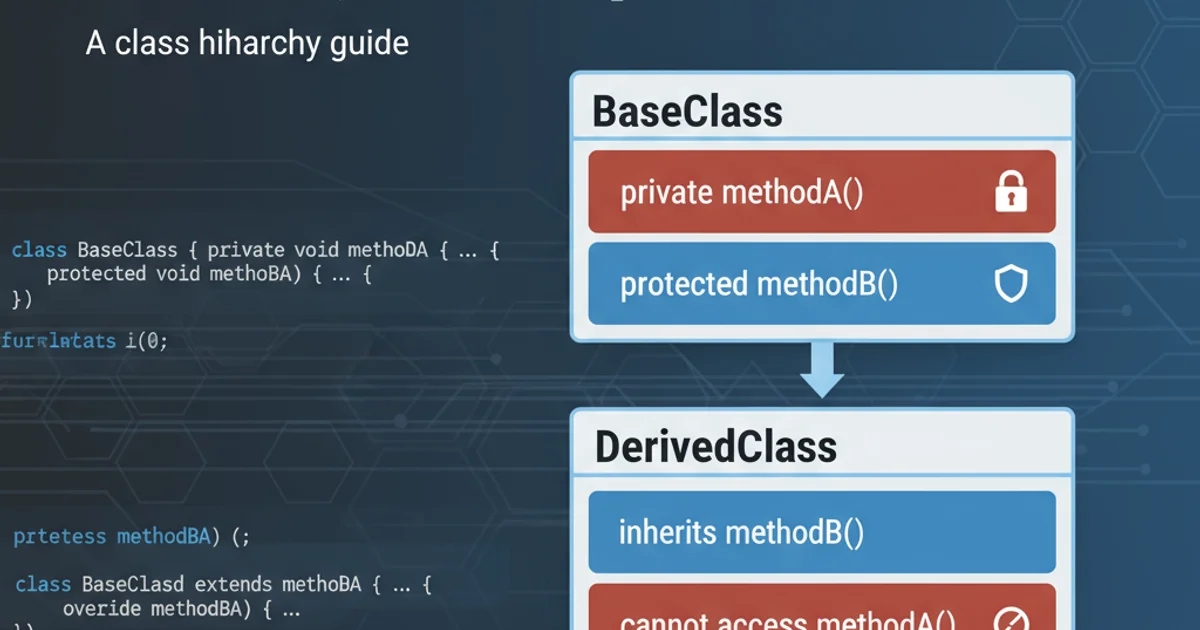When do you write a private method, versus protected?
Categories:
Private vs. Protected Methods: Understanding Access Control in OOP

Explore the nuances of private and protected methods in Object-Oriented Programming, when to use each, and their impact on inheritance and encapsulation.
In Object-Oriented Programming (OOP), access modifiers like private and protected are fundamental for controlling the visibility and accessibility of class members. Choosing between them is crucial for designing robust, maintainable, and secure software. This article delves into the definitions, use cases, and implications of both private and protected methods, helping you make informed decisions in your class designs.
Understanding Private Methods
A private method is accessible only from within the class in which it is declared. It represents an internal implementation detail that should not be exposed to subclasses or external code. The primary purpose of private methods is to enforce encapsulation, ensuring that the internal workings of a class can be changed without affecting its external interface or behavior in derived classes.
public class BankAccount {
private double balance;
public BankAccount(double initialBalance) {
this.balance = initialBalance;
}
// Private helper method for internal validation
private boolean isValidAmount(double amount) {
return amount > 0;
}
public void deposit(double amount) {
if (isValidAmount(amount)) {
balance += amount;
System.out.println("Deposited: " + amount + ", New balance: " + balance);
} else {
System.out.println("Invalid deposit amount.");
}
}
// Other public methods...
}
Example of a private method in Java
private methods for utility functions or complex logic that is only relevant to the internal operations of a single class. This reduces coupling and makes refactoring easier.Understanding Protected Methods
A protected method is accessible within its own class and by subclasses (derived classes) in the same package (in Java) or any package (in C++ and C#). It signifies that the method is part of the class's internal API, intended for extension by subclasses, but not for general public use. protected methods are often used to provide hooks for subclasses to customize behavior without exposing the full implementation details to the outside world.
public abstract class Vehicle {
protected String make;
protected String model;
public Vehicle(String make, String model) {
this.make = make;
this.model = model;
}
// Protected method intended for subclasses to implement specific behavior
protected abstract void startEngine();
public void drive() {
startEngine(); // Calls the subclass's implementation
System.out.println(make + " " + model + " is driving.");
}
}
public class Car extends Vehicle {
public Car(String make, String model) {
super(make, model);
}
@Override
protected void startEngine() {
System.out.println("Car engine started with a key.");
}
}
public class ElectricCar extends Vehicle {
public ElectricCar(String make, String model) {
super(make, model);
}
@Override
protected void startEngine() {
System.out.println("Electric car motor engaged silently.");
}
}
Example of a protected abstract method in Java and its implementation in subclasses
protected methods allow extensibility, they can also create a tight coupling between a base class and its subclasses. Changes to a protected method in the base class might require changes in all derived classes, potentially violating the Open/Closed Principle if not managed carefully.When to Choose Which: A Decision Flow
The choice between private and protected boils down to your intent regarding inheritance and extensibility. If a method is purely an internal helper and should never be overridden or directly accessed by subclasses, make it private. If you anticipate that subclasses might need to access or modify the method's behavior to extend the base class's functionality, then protected is the appropriate choice.
flowchart TD
A[Method Functionality] --> B{Is it an internal helper for this class only?}
B -- Yes --> C[Make it Private]
B -- No --> D{Do subclasses need to access or override it?}
D -- Yes --> E[Make it Protected]
D -- No --> F[Consider Public or Package-Private]Decision flow for choosing between private and protected methods
Impact on Encapsulation and Inheritance
Encapsulation is about bundling data and methods that operate on the data within a single unit (the class) and restricting direct access to some of the class's components. private methods are the strongest form of encapsulation, completely hiding implementation details. protected methods offer a weaker form of encapsulation, exposing internal details to a controlled set of classes (subclasses). While protected methods facilitate inheritance and polymorphism, they also mean that the internal structure of the base class is partially exposed, which can make future refactoring more challenging.
In summary, private methods are for internal class use only, promoting strong encapsulation and allowing for internal refactoring without impacting external code or subclasses. protected methods are for internal use within the class and by its subclasses, facilitating controlled extensibility. Understanding this distinction is key to designing flexible and maintainable object-oriented systems.